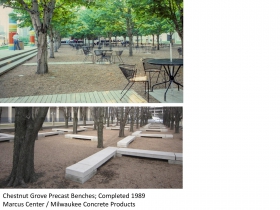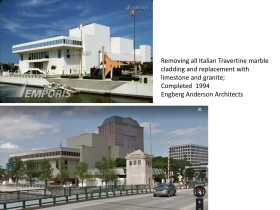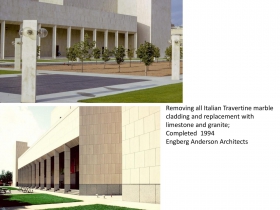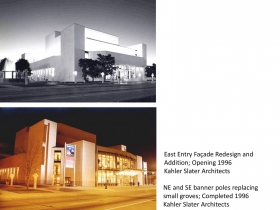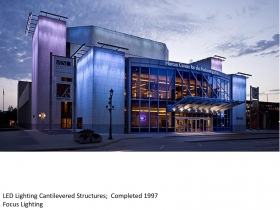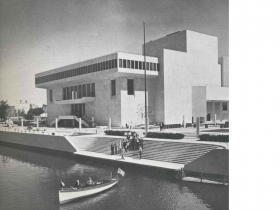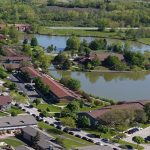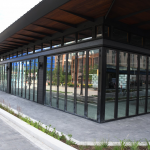The Marcus Center is Historic. For Now
Commission grants temporary historic designation, though Marcus Center opposed it.
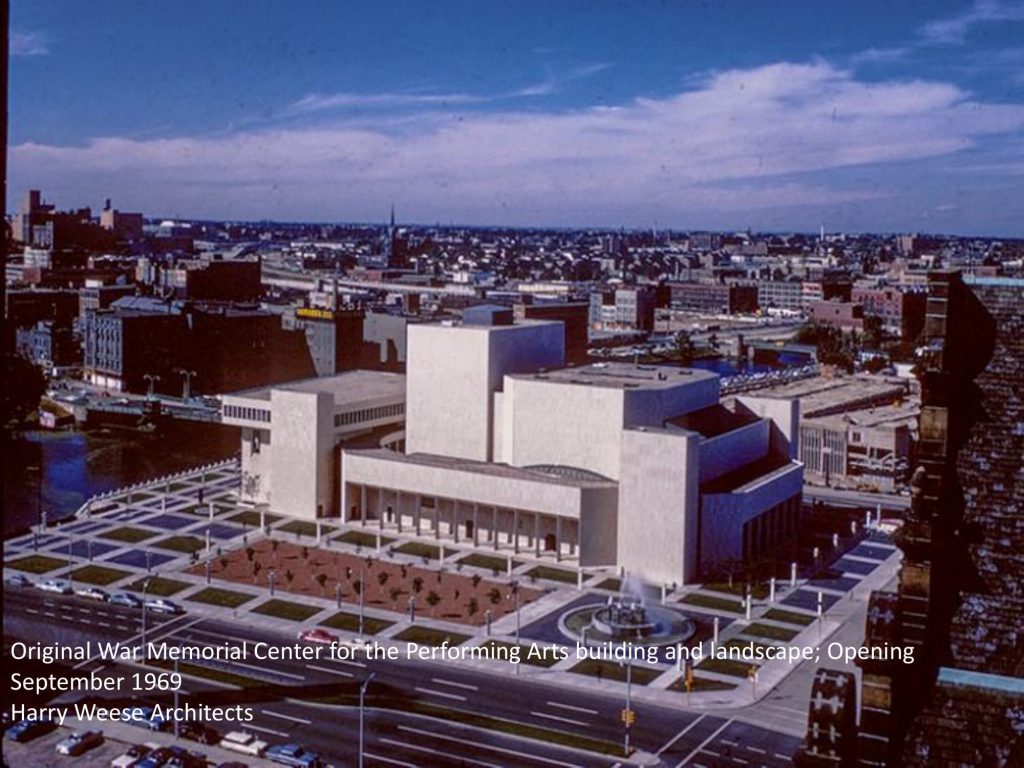
The Marcus Center for the Performing Arts in 1969. Image provided to Historic Preservation Commission by Jim Shields.
The Marcus Center for the Performing Arts has been granted temporary historic status by the Historic Preservation Commission, effectively halting any exterior work.
The designation, which lasts no more than 180 days, comes after the commission spent almost an hour hearing testimony on the proposal, including that improper notice was given, the building has been substantially altered, the tree grove is dying and the delay could force the cancelation of free summer programming.
The 3.65-acre complex at 929 N. Water St. originally opened in 1969. Designed by architect Harry Weese, the grounds include a landscaping plan from landscape architect Dan Kiley. A number of firms have worked on alterations to the complex in the last 50 years.
Landscape architect Jennifer Current and architect Mark Debrauske nominated the structure for local historic designation in January, but Current told the commission she was already working towards preserving the grounds before the Marcus Center unveiled its redevelopment proposal. “This began not with the proposal, but with an exhibition at UW-Milwaukee form the Cultural Landscape Foundation about Dan Kiley,” said Current.
Hatala also concluded the grounds, including the tree grove, were worthy of designation. “The two parts cannot be separated from one another because they were conceived together,” Hatala told the commission.
But Marcus Center president Paul Mathews wants no such designation. “We need to proceed on the plans,” said Mathews. “There are maintenance items we have to pay attention to in the short term. It could affect our summer, free programming on the outside.” Mathews’ organization leases the facility from Milwaukee County and is required to cover all maintenance costs. “I just want you to understand that in a six month period there may be consequences that you should be aware of,” concluded Mathews.
Mathews was joined in opposing the designation by the organization’s attorney Michael Ostermeyer. “It’s pretty clear that the commission has no authority to render a decision on this,” said Ostermeyer after raising concern that proper notice was not given to the Milwaukee RiverWalk business improvement district. “I do not accept the premise of your argument, absolutely not,” said Alderman and commission member Robert Bauman. “If you disagree with that you have your day in court.”
But it was architect Jim Shields, who is leading the redesign, that introduced a potentially persuasive argument. “My main purpose is to suggest that the building has seen such alterations that it’s not designatable under the ordinance,” said Shields. “I don’t have much doubt that if the building were close to its original condition it would be designatable today.”
Shields walked the commission through a PowerPoint presentation showing the alterations, including new loading docks, a fenced-in concession area, creation of the Peck Pavilion and heavily-altered staircase. “I want to advise the commission if you’re going to designate the building to be fairly surgical about it.” But he found three modifications to draw particular attention to, the alteration of the grove, the recladding of the building and the redesign of the building’s main entry.
Showing before-and-after photos of the grove from 1989, Shields characterized the addition of precast, concrete benches as “a sad blocking of the open space of the grove.”
In 1994, the building’s Italian marble facade was reported to be cracking and falling off. “I consider this a fatal blow to it,” said Shields of the new facade that includes Minnesota limestone and a granite base. “This is really a different building now, and is not the monumental cultural object that people remember.”
“The biggest one for me actually is the loss of the entry facade,” said Shields. A colonnade entrance was replaced with an expanded lobby and large glass facade. “I can’t imagine another scenario where a building could have its main entry torn off and replaced in the mid-1990’s and you could designate the building.”
Shields’ presentation drew interest, but the commission concluded he’ll need to make it again at the permanent designation hearing. In motioning to grant the building temporary designation, Bauman said: “I want to thank Mr. Shields for providing legitimate issues that are worth considering as we look at permanent designation.”
In a statement following the commission’s action, Mathews told Urban Milwaukee: “We are disappointed with the Commission’s decision to grant temporary historic designation to the Marcus Center. The simple fact is that the Marcus Center is not a good fit for designation because the building and campus have undergone such vast alterations. In less than 50 years, the site has seen 11 major renovations implemented by 6 designers, including entirely new cladding on the entire building and a newly designed front entry facade.
We respect the Commission’s work and look forward to the opportunity to present at a public hearing regarding permanent designation. We encourage the Commission to schedule the hearing as soon as is reasonable to help achieve certainty regarding how the Marcus Center will approach needed campus renovations.
We are concerned that delay will create significant challenges as we embark on the critical campus improvements that are necessary to meet our mission to be a welcoming, open and accessible arts center, as well as to ensure our long-term financial sustainability.”
Shields’ Presentation
If you think stories like this are important, become a member of Urban Milwaukee and help support real independent journalism. Plus you get some cool added benefits, all detailed here.
More about the Marcus Center redevelopment
- Eyes on Milwaukee: Marcus Center Unveils New Grounds - Jeramey Jannene - Nov 14th, 2022
- Eyes on Milwaukee: Marcus Center Starts Construction On Former Chestnut Grove - Jeramey Jannene - May 31st, 2022
- Plats and Parcels: Marcus Center Begins Redevelopment - Jeramey Jannene - Sep 20th, 2020
- Eyes on Milwaukee: Council Says Marcus Center Not Historic - Jeramey Jannene - May 7th, 2019
- Eyes on Milwaukee: Committee Says Marcus Center Isn’t Historic - Jeramey Jannene - Apr 30th, 2019
- Marcus Center Trees Removed Before Permit Issued - Jeramey Jannene - Apr 9th, 2019
- Eyes on Milwaukee: Marcus Center, Kiley Grove Deemed Historic - Jeramey Jannene - Apr 1st, 2019
- Murphy’s Law: Kiley’s Chestnut Grove Provokes Hot Debate - Bruce Murphy - Mar 7th, 2019
- Eyes on Milwaukee: Marcus Center Decision Delayed A Month - Jeramey Jannene - Mar 5th, 2019
- Eyes on Milwaukee: Marcus Center at a Crossroads - Jeramey Jannene - Mar 4th, 2019
Read more about Marcus Center redevelopment here
Political Contributions Tracker
Displaying political contributions between people mentioned in this story. Learn more.
- March 22, 2017 - Robert Bauman received $100 from Paul Mathews
- February 12, 2016 - Robert Bauman received $50 from Paul Mathews
- November 19, 2015 - Robert Bauman received $100 from Paul Mathews
- March 21, 2015 - Robert Bauman received $100 from Paul Mathews
Eyes on Milwaukee
-
Church, Cupid Partner On Affordable Housing
 Dec 4th, 2023 by Jeramey Jannene
Dec 4th, 2023 by Jeramey Jannene
-
Downtown Building Sells For Nearly Twice Its Assessed Value
 Nov 12th, 2023 by Jeramey Jannene
Nov 12th, 2023 by Jeramey Jannene
-
Immigration Office Moving To 310W Building
 Oct 25th, 2023 by Jeramey Jannene
Oct 25th, 2023 by Jeramey Jannene


